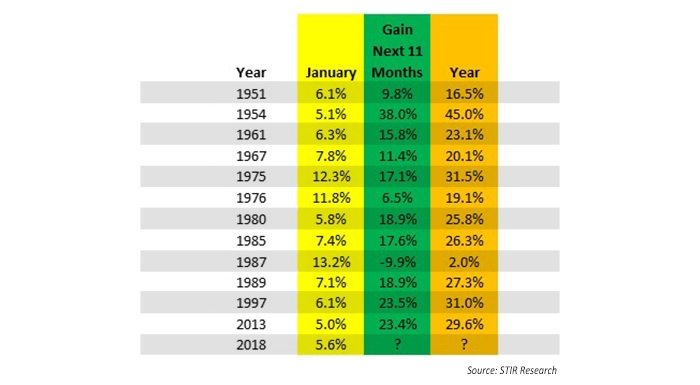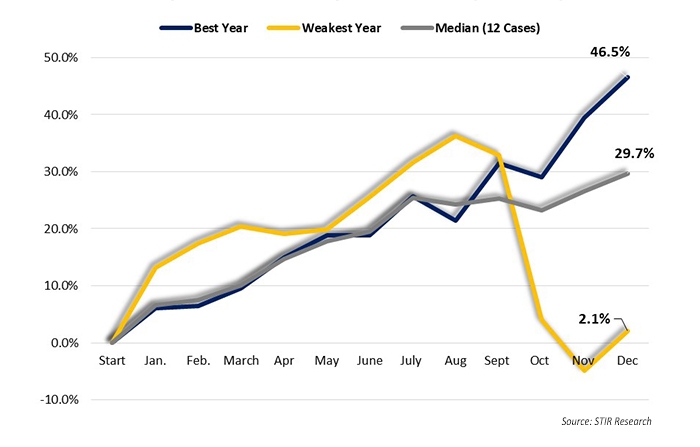

The good news is that the markets were off to their fastest start in 20 years in 2018, with a January gain of 5.6%.
The bad news is that also put the market into an overbought position and a pullback was highly anticipated at some point. However, a fast and dramatic sell-off of over 10% on an intraday basis is probably more than what most investors expected.
Yet, even in a great market year like 2017, the S&P 500 on several occasions briefly traded below its 50-week moving average. In each case, the market bottomed shortly thereafter and rallied. On Monday (2/5/18), it was again below its 50-day moving average and at a new low for the year. Eleven months from now we will look back and, I believe, see this was a good time to be adding to equities, not selling.
One of the reasons for my belief is that corporate earnings should act as a supportive element for the market when all is said and done in 2018.
From a qualitative perspective, security analysts are scrambling to come up with new 2018 earnings projections. Before the corporate tax cut, estimates were for a 10% increase in earnings. After the tax cut, estimates were raised to 14%–15%. But that could still be low. Q4 earnings have been coming in with gains of more than 12% on a year-over-year basis versus the 9% analysts were predicting in December. The tailwinds of a stronger-than-expected Q4 could push 2018 earnings estimates even higher in the weeks and months to come.
From a quantitative perspective, the picture is even better. Yale Hirsch, founder and editor of the Stock Trader’s Almanac, first introduced the January barometer back in 1972. Simply stated, his analysis showed that the direction of the S&P 500 in January has a high degree of accuracy in predicting the results of the entire year:
- There’s a 74.6% batting average on correctly predicting the rest of a calendar year based on whether January was positive or negative.
- Every down January for the S&P 500 since 1950, without exception, preceded a new or extended bear market, a flat market, or a 10% correction (2016 is a recent example).
- Since 1950, the market has had 39 up Januarys, which has translated into 37 years of finishing in positive territory.
All in all, a very impressive record.
However, by digging deeper into the data, we see an even stronger pattern where really big Januarys, those with gains of over 5%, have an even better track record of predicting the outcome for the year and signaling higher returns.
TABLE 1: S&P 500 PERFORMANCE AFTER JANUARY GAINS OVER 5%

January gains of over 5% are not that common but lead to several observations:
- Over the past 68 years, we have had just 12 prior occurrences, or once every six years.
- 75% of the Januarys with greater than 5% gains occurred in secular bull markets.
- 100% of the time, the S&P ended in the green.
- Double-digit gains over the following 11 months (February through December) occurred 75% of the time.
- 92% of the time, the following 11 months of the year showed gains.
- 92% of the time, the year ended with a double-digit gain.
So, what could the 2018 market rally still end up looking like? By taking the median monthly gains of the past 12 cases of Januarys with 5% gains, the results show the potential for a strong 2018—despite the recent pullback.
FIGURE 1: YEARLY RETURN WHEN JANUARY GAINED OVER 5% (SINCE 1949)

Bottom line, in my opinion? While many investors may be spooked by the spike in volatility over the past week, the 2018 market rally is likely going to resume after a corrective period. The median historical gain for the remaining 11 months of the year after strong Januarys is almost 22%. If the median 12-month return of such years holds true for 2018 from current levels, we will be seeing over 3,200 for the S&P 500 and a Dow Jones Industrial Average perhaps breaking 30,000 by the end of the year.
The opinions expressed in this article are those of the author and do not necessarily represent the views of Proactive Advisor Magazine. These opinions are presented for educational purposes only.
 Marshall Schield is the chief strategist for STIR Research LLC, a publisher of active allocation indexes and asset class/sector research for financial advisors and institutional investors. Mr. Schield has been an active strategist for four decades and his accomplishments have achieved national recognition from a variety of sources, including Barron's and Lipper Analytical Services. stirresearch.com
Marshall Schield is the chief strategist for STIR Research LLC, a publisher of active allocation indexes and asset class/sector research for financial advisors and institutional investors. Mr. Schield has been an active strategist for four decades and his accomplishments have achieved national recognition from a variety of sources, including Barron's and Lipper Analytical Services. stirresearch.com
